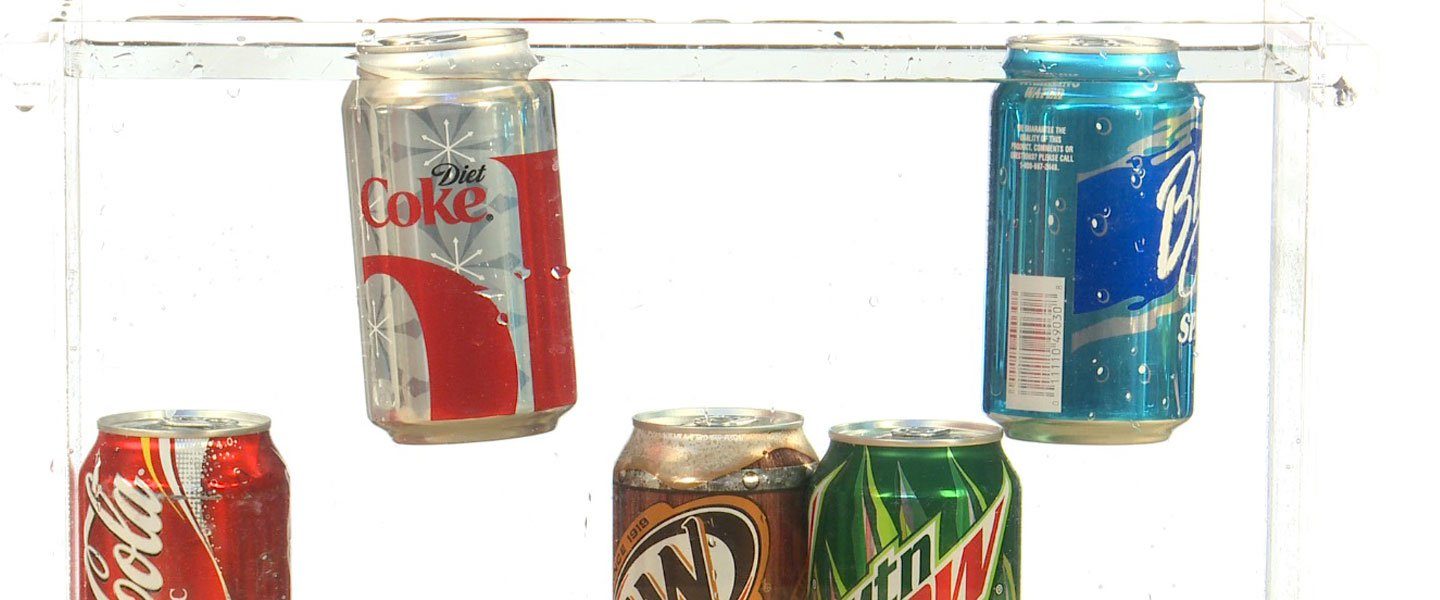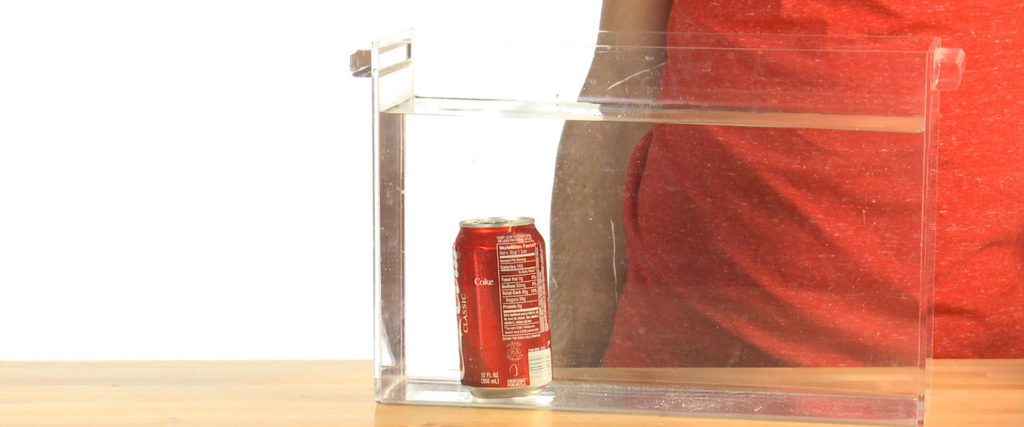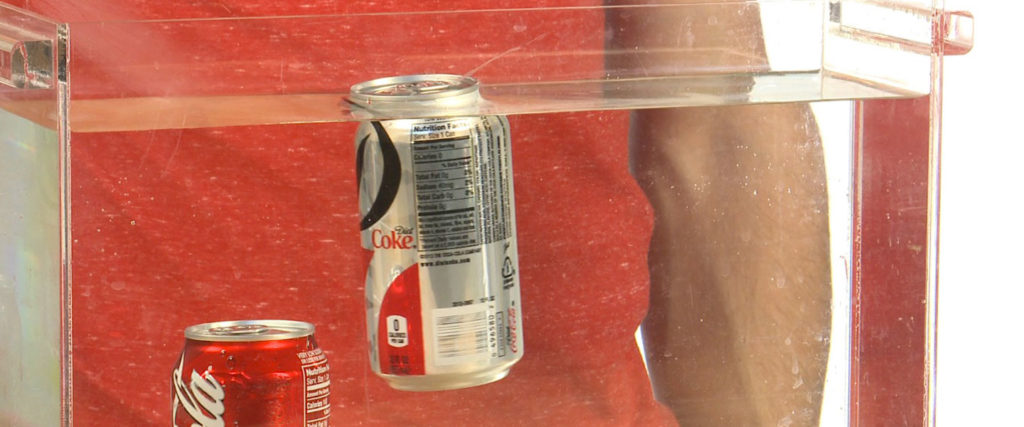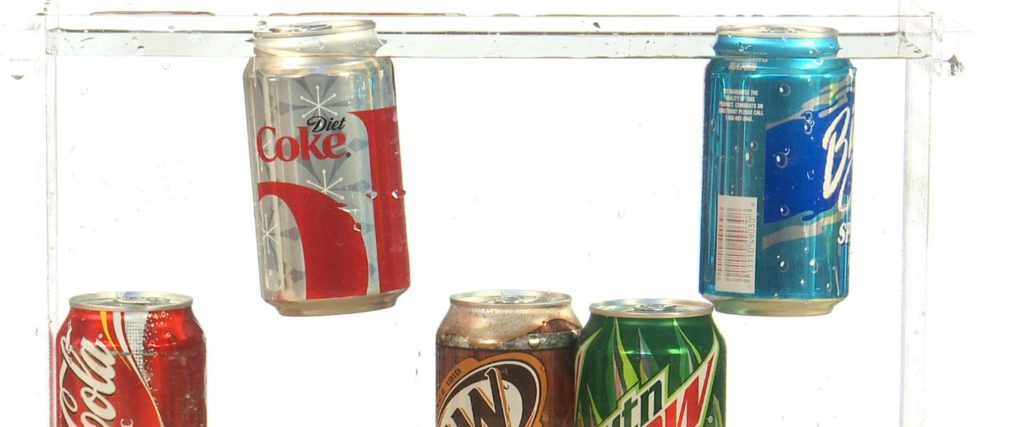Light Ice, Heavy Water
You know that materials have different densities. For a perfect, amazing example of how to demonstrate these different densities, check out our 9 Layer Density […]

I remember as a kid diving to the bottom of the swimming pool to retrieve unopened cans of soda pop. Our parents tossed the unopened cans of soda into the pool as a game on the Fourth of July or any time they wanted to keep us busy. So, based on my personal experience, I knew that unopened cans of soda sink in water . . . until I saw my first can of soda float. Why do some cans of soda float and others sink?

Ask your audience the question: “Will this can of regular soda float or sink in the bucket of water?” After gathering everyone’s answer, place the can of regular soda in the water and notice that it sinks to the bottom.

Pick up a can of diet soda and pose the same question. Be sure to point out the fact that the cans are exactly the same size and shape and contain the same amount of liquid (compare the number of milliliters—probably 355 mL). Place the can of diet soda in the water. It floats! Wobble the can from side to side to show your audience that there are no bubbles trapped under the bottom. It still floats. Why?

Let your group experiment with different kinds of soda. Why do the diet sodas float and the regular sodas sink, no matter the brand?
This demonstration is an excellent way to learn about density. You can determine how dense an object is by using the density equation: Density = Mass divided by Volume. The density of water is 1.0 grams per milliliter. Any object that has a density greater than 1.0 g/mL will sink and any object with a density of less than 1.0 g/mL will float.
Let’s look at the variables. Volume refers to how much space an object occupies. For fluids, volume is usually measured in liters (L) or milliliters (mL). When you compared the different cans of soda, you probably noticed that the cans contained the same amount of liquid (355 mL). Since the cans of soda used for this experiment have the same volume, the only variable left to consider in the density equation is the mass. In order for the density to change, the mass must change . . . and it does!
If a diet and a regular soda can are placed on a double-pan balance scale, it quickly becomes clear that the regular soda is heavier (or has more mass) than the diet soda. Mass refers to how much stuff exists within an object, and for the purposes of our experiment, mass is measured in grams.
What’s inside the can of regular soda that makes it so much heavier than diet soda? Comparing the list of ingredients on both cans you see that a can of regular soda has about 150 calories while diet soda has 0 calories. All of those calories come from one place . . . sugar! Diet sodas usually contain aspartame, an artificial sweetener, while regular sodas use sugar. Take a look at the nutritional information on the side of the cans. Notice how much sugar is in a regular soda (look under carbohydrates). Most regular sodas have between 39 and 43 grams of sugar. This added mass is why the cans of regular soda sink in water.
So, how much is 40 grams of sugar? If you go to a restaurant and order tea, some people add two or three packets of sugar (okay, some people stir in six packets of sugar, but we’re talking about the average person). How many packets of sugar make up 40 grams? Of course, not every packet of sugar is the same, but a little research of the published nutritional information from fast food restaurants in the United States revealed that a packet contains about 4 grams of sugar, and those 4 grams of sugar have 15 calories. This means that there about ten packets of sugar in a can of regular soda, accounting for the 150 calories. That’s a lot of sugar!
So the density of a soda actually depends on how much sugar or sweetener is used. The 40 grams of sugar added to a can of regular soda make it sink, and the relatively tiny amount of artificial sweetener used in diet soda has a negligible effect on the mass, enabling the can to float.
Try the experiment again using salt water. Are your results any different? What if you continue adding salt? How much salt do you have to add before your results change?
Consider changing the temperature of the water or the temperature of the cans. Do either of those changes affect the results?
Note: If the can of regular soda floats, there might be an air bubble trapped under the bottom of the can. Tip the can to the side to release the pocket of air trapped under the can.